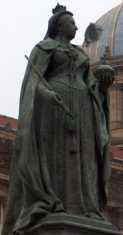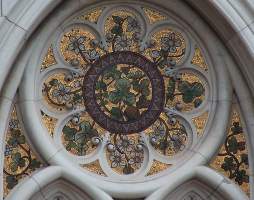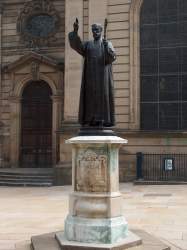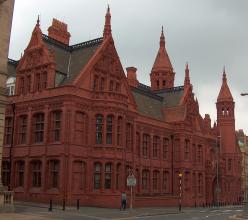 Queen Victoria, by Thomas Brock.
Queen Victoria, by Thomas Brock.
Birmingham is home to some good Victorian sculptures, and the city authorities still encourage public art. With a short walk starting at the Museum and Art Gallery there is opportunity to compare the modern with the 19th Century sculpture as well as see the Burne-Jones windows in the Cathedral. Further information on places of interest is linked to from the Introduction to Birmingham pages.
Starting from Chamberlain Square/Victoria Square by the Museum, the best sculpture is Queen Victoria herself, who stands on a tall pedestal by the classical Council House. The sculptor was Thomas Brock, but the deterioration of the original marble, dating from 1901, meant it had to be recast in bronze by William Bloye 50 years later. The queen looks suitably severe, but this is a very human queen, a mortal queen, and not changed into a symbol of Empire as is the case for, say, the Victoria Memorial version in London.
 Queen Victoria, by Thomas Brock.
Queen Victoria, by Thomas Brock.
Close to the library are two more statues of Victorian times - the great engineer Watt and Priestley, discoverer of oxygen, by Munro and F. J. Williamson. Both these statues are slender, and are well placed next to each other. They look down, more or less towards the Chamberlain Memorial and fountain, a Gothic construction with interesting mosaics of flowers, designed by J. H. Chamberlain (no relation) and put up in 1880.
Munro's statue of James Watt, and mosaic from the Chamberlain Memorial.

The other main Victorian sculptures are, of course, the architectural ones on the Council House itself and above the entrance to the Museum. The main triangular pediment is accompanied by two semicircular pediments on the ends of the wings facing the square, and one around each corner, and show classical figures in Greek style. The sculptor was again, I think, F. J. Williamson. A good mosaic above the main entrance completes the scheme, showing industry etc that have contributed to the wealth of Victorian Birminham. The Council Buildings were designed by Yeoville Thomason in 1874, with giant Corinthian columns, a dome, and a clock tower ('Big Brum') as a reduced-scale equivalent to London's Big Ben. Thomason added the more ornate Museum and Art Gallery on the side during the 1880s.
 Pedimental sculpture on the Council House.
Pedimental sculpture on the Council House.
The main modern sculpture is directly in front of the Town Hall and occupies the centre of Victoria Square. It is based around a fountain with cascade, containing a garganuan nude woman in the top pool and a couple of small, slender figures in the lower pool, with flanking sphinxes of large size. These sculptures are the work of Dhruva Mistry RA and date from 1993. The colossal nude is called The River, and is bronze. The sphinxes (the Guardians) are close to the Assyrian type, with rear legs ending in hooves. All however are in a modern idiom, with elongated necks, blank stares, and with a smooth finish rather than an attempt at fine detail. They are strange, difficult to get used to, but seem to me to be by far the best of the modern sculpture in Birmingham. As well, the scale is large enough that they fit with the dominating architecture all around. In contrast, the two small figures in the lower pool provide a more intimate feel. I am less favourable towards the other piece of sculpture in the square, Iron Man by Anthony Gormley (1993).
We should also mention the old Town Hall, free-standing and surrounded by impressive Corinthian columns, was based on the Temple of Castor and Pollax in Rome. The architect was Joseph Hansom, inventor of the Hansom cab, and the building was begun in 1832, though unfinished until the 1860s.
Along the right hand side of the Town Hall is Colmore Row, with impressive highly-decorated limestone buildings (Woolwich, Royal Bank of Scotland). There are full and half figures, supporting cranes, and best of all, elegant spandrel figures above the Royal Bank of Scotland door. A brief diversion down Newhall Street as far as no. 56 (the Exchange) shows a good example of terracotta decoration, an industry largely centred around Birmingham. The Exchange was built in 1896, and architectural features include leaf patterns, heads and dragon gargoyles.
 Bishop Gore, by St Philip's Cathedral.
Bishop Gore, by St Philip's Cathedral.
Returning to Colmore Row and continuing a few paces leads to the Cathedral (St Philip's). Originally built as a church in the early 18th Century, it was given the status of Cathedral in 1905. In the square surrounding, a statue of the first cathedral Bishop, Charles Gore (ca.1914), by Thomas Stirling Lee. The cathedral must be one of the smallest of its breed, but contains inside four very important Burne-Jones windows. These are excellent examples of his work, and obtain a superb jewelled effect found with most Burne-Jones stained glass. Three of the four windows are at the sumptious altar end of the church, which has round and square Corinthian style columns, the round ones being painted to resemble marble. Inside, we might also note the small monument to Moses Haughton (d. 1804), 'eminent artist', with a good high relief portrait in profile with books and painters' tools strategically placed. As well, the monument to the Wilkes family, with an 1860s classical treatment of a girl with vase.
(Not far off, via Colmore Circus and St Chad's Circus, Pugin's St Chad's Roman Catholic Cathedral may be visited.)
Leaving the Cathedral precinct, cutting through Temple Street allows access to New Street. In Temple Street is a Law Library, with an interesting small roundel with figures from 1870. Parellel roads leading from New Street are also highly explorable, with, for instance, more terracotta and two grotesque heads in Cannon Street, and colourful modern painted ceilings in the restored Piccadilly Arcade.
A couple of minutes walk brings us back to the Art Gallery and Museum, and leisure to reinspect the sculpture within. Here, this notably incudes the earliest Pre-Raphaelite statue, Alexander Munro's delicate Paolo and Francesca, Frampton's symbolist Lamia, and a series of maquettes -Leighton's Athlete with Python, Carlo Lucchesi's erotic and symbolist The Myrtle's Altar and several works by Alfred Gilbert (Icarus, St Catherine, Comedy and Trajedy and Anteros). All these are in the Pre-Raphaelite galleries. We may also mention the highly classical bust of Edward Johnstone by Chantrey, and the powerfully executed 20th Century sculpture of Lucifer by Epstein.
 The Law Courts, in terra cotta.
The Law Courts, in terra cotta.
The best terra cotta building in Birmingham is the Law Courts in Corporation Street, and these are described on a separate page.
Birmingham pages // Sculpture in England // Sculpture pages
Visits to this page from 23 Nov 2011: 6,574